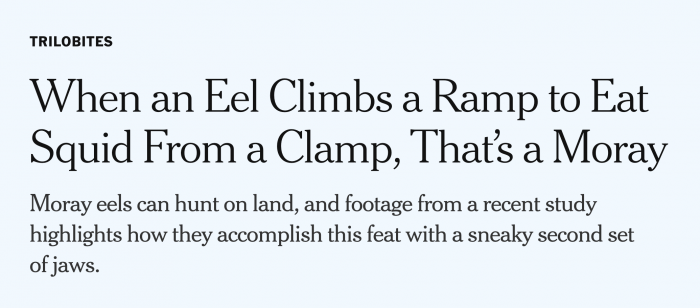
Two weeks into their science fellowship with The New York Times, Sabrina Imbler wrote what media Twitter has unofficially but overwhelmingly deemed the world’s best headline.
the perfect headline doesn't exis–https://t.co/WRN37RDGMx pic.twitter.com/JOBuzcmvUm
— Josh Billinson (@jbillinson) June 22, 2021
Next year’s Pulitzers are settled real early https://t.co/nUGXwckWbX
— Benjy Sarlin (@BenjySarlin) June 22, 2021
good morning ONLY to NYT headline writers https://t.co/iafGEgrL2A pic.twitter.com/uvitKdfVnL
— Eli Yokley (@eyokley) June 22, 2021
The rest of us should take the day off because we’ll never top this. https://t.co/SebzjRx1m4 pic.twitter.com/Wo7kaRw756
— Laura J. Nelson 🦅 (@laura_nelson) June 22, 2021
Imbler, 26, who is also writing a book about sea creatures for Little, Brown, stressed that the headline’s format was a joint production with Michael Roston, the Times’ senior staff editor for the science section. Roston was “the memelord who came up with the format,” Imbler told me via DM.
Roston explained that he’d come across Times columnist Carl Zimmer’s retweet of one of the eel videos, and “because I’ve been on the internet too long, I immediately started thinking of ‘that’s a moray’ tweets to go with it, and I even tweeted one last week.”

🎶When an eel that’s on land
Gets a meal from a hand
That’s a moray🎶 https://t.co/HOzHywlVRY— Michael Roston (@michaelroston) June 16, 2021
When they filed the story, Imbler had written “When an eel climbs a ramp to eat squid from a clamp, that’s a moray” as the dek. Roston decided it should be the headline, and then he and Imbler wrote more Dean Martin-inspired rhymes to caption the photos in the story.
“I triply checked that the forceps were technically clamps, so as not to introduce any errors in pursuit of the bit,” Imbler said.
One comment:
MkpEBlIHVvnNPJ
Trackbacks:
Leave a comment